Are you aware that the proverb “Failing to plan is planning to fail”? This holds across many industries, including healthcare. Planning is done to ensure that the organization operates smoothly and effectively even if the HR planning process has the almost same objectives. Workforce planning may involve workforce analysis for planning, forecasting, and other purposes. The goal of the entire planning process is to assess the organization’s present and future needs, fill in any gaps, and find growth opportunities. Workforce planning is also known as Strategic workplace planning, it aids and supports an organization in sustaining effective operations to accomplish its objectives.
Workforce planning assists the organization in developing a hiring strategy, such as assigning which department head to which position when hiring is required. This helps to guarantee that the appropriate amount of qualified experts is available at the appropriate moment. These are only a few of the many advantages of workplace planning that we will learn about in this blog post. In addition, we will go over the key considerations that hospitals must keep in mind when working on their plans to see some real, and noticeable benefits.
Decoding the Benefits of Workplace Planning
An organization’s workforce research and planning, as well as the HR planning process, are just as important to its success as its workforce when it comes to reaching new heights. Let’s explore the various advantages of workforce planning and the reasons it is a crucial tool that everyone should have.
Improved patient & Hospital Outcomes
Similar to how issues in one department impact the organization as a whole, improvements in one department have a similar, but favorable, impact on the organization. A workforce strategy plan helps healthcare facilities hire qualified professionals who fill staffing gaps and address potential shortages. It also helps to maintain an ideal patient-to-staff ratio, which improves patient outcomes and improves hospital outcomes overall.
Less Burnout
One of the major problems that lowers employee potential and ultimately impacts an organization’s overall turnover rate is workforce burnout. You may control the amount of work that your employees have to do by using strategic fourth planning. Now that workloads are reasonable and staffing levels are acceptable, the workplace has a more encouraging atmosphere, which eventually results in increased job satisfaction, greater retention rates for healthcare professionals, and a decrease in burnout.
Workforce Efficiency
Workforce planning facilitates the onboarding of new employees by assigning tasks and times to each department. Organizations can avoid disruptions and guarantee that new hires receive the required training and assistance from the outset by anticipating personnel demands and making appropriate preparations beforehand. This method aids in maintaining operating efficiency, preventing overstaffing or understaffing, and balancing workloads.
Finance & resource optimization
Additionally, when everything is planned, costs are also reduced. Without sound planning, an organization frequently experiences unneeded financial losses and poor budgetary management. An organization’s ability to manage its budget is directly correlated with its personnel planning. Forecasting personnel demands and matching them to available funds allows organizations to minimize unnecessary spending and maximize their output. The sustainability of healthcare services depends on this budgetary restraint.
Ease in managing talent
Healthcare companies may proactively hire and retain top people by understanding their future employment needs. Workforce planning makes it simple for companies to create a pool of qualified candidates and handle labor shortages before they hurt hospital administration and patient care as a whole.
Things to remember for effective workforce planning

Effective workforce planning requires careful execution, which entails paying close attention to detail and taking into account a variety of other aspects that contribute to the best possible outcomes. The following are some factors to take into account while designing a workforce effectively.
Workforce analysis includes collecting and analyzing data regarding the workforce’s demands inside the organization as a whole. The Health Care Management can detect possible gains or surpluses with the aid of this data.
Strategies, participate significantly in planning. The techniques include assessing the skills shortages in the workforce, projecting and analyzing existing and future demands, and creating workable plans to fill these gaps. This entails hiring and preparing workers for important positions, putting succession planning into place to guarantee leadership continuity, and using data-driven insights to predict future workforce needs.
Continuous Evaluation in workforce planning is a continuous process rather than a one-time event. Review and modify your workforce plans frequently in response to staff input, performance indicators, and shifts in the healthcare environment. Workforce initiatives are kept effective and in line with company goals with the support of ongoing evaluation.
Flexibility and Adaptability Healthcare settings are dynamic and subject to quick changes. Planning for the workforce should be flexible enough to adjust to unanticipated shifts in patient demand, new rules governing healthcare, or other outside circumstances. Developing a flexible workforce plan aids in an organization’s ability to adapt and stay strong.
Conclusion
In the healthcare industry, workforce planning is essential to providing patients with high-quality care and guaranteeing operational effectiveness. Healthcare businesses may boost employee satisfaction, improve patient outcomes, and manage resources more efficiently by proactively aligning staffing needs with corporate goals and patient expectations. Adopting a collaborative, adaptable, and data-driven workforce planning approach aids healthcare providers in navigating the industry’s challenges and preserving a strong and competent workforce. In the end, efficient workforce planning benefits both employees and patients by supporting the general prosperity and sustainability of healthcare organizations.

